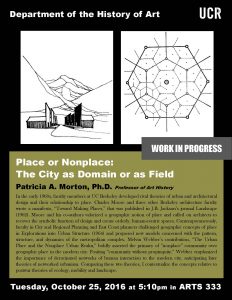Work In Progress Series – Patricia A. Morton, PhD

Work in Progress Series — Patricia A. Morton, PhD
Place or Nonplace: The City as Domain or as Field
Patricia A. Morton, Ph.D. Professor of Art History
In the early 1960s, faculty members at UC Berkeley developed rival theories of urban and architectural design and their relationship to place. Charles Moore and three other Berkeley architecture faculty wrote a manifesto, “Toward Making Places,” that was published in J.B. Jackson’s journal Landscape (1962). Moore and his co-authors valorized a geographic notion of place and called on architects to recover the symbolic function of design and create orderly, human-centric spaces. Contemporaneously, faculty in City and Regional Planning and East Coast planners challenged geographic concepts of place in Explorations into Urban Structure (1964) and proposed new models concerned with the pattern, structure, and dynamics of the metropolitan complex. Melvin Webber’s contribution, “The Urban Place and the Nonplace Urban Realm,” boldly asserted the primacy of “nonplace” community over geographic place in the modern city. Positing “community without propinquity,” Webber emphasized the importance of deracinated networks of human interaction to the modern city, anticipating later theories of networked urbanism. Comparing these two theories, I contextualize the concepts relative to postwar theories of ecology, mobility and landscape.
